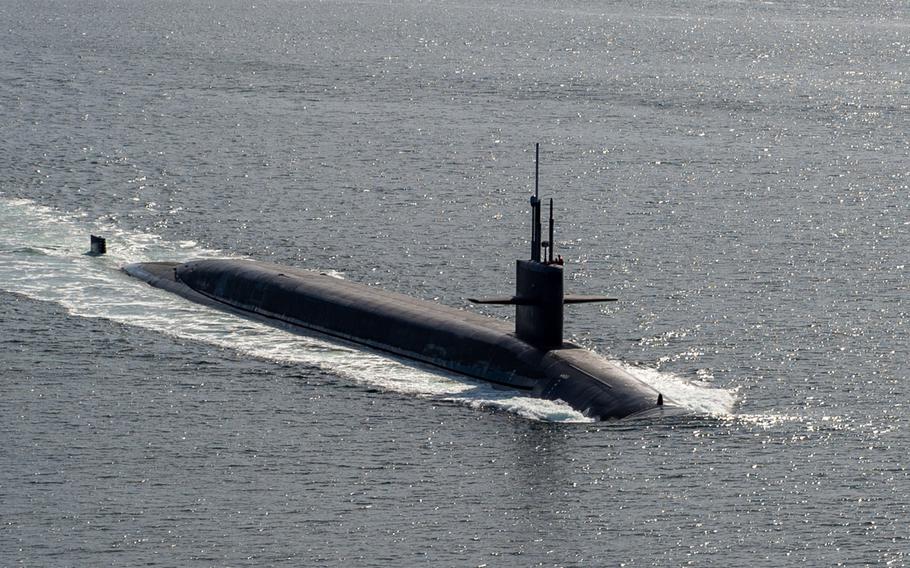
USS Maine, an Ohio-class nuclear ballistic missile submarine, transits Puget Sound near Seattle in March 2025. (Ryan Riley/U.S. Navy)
The Navy plans to spend up to $250 million to extend and modernize a pier at Naval Base Kitsap-Bangor to serve new ballistic missile and attack submarines coming into the fleet in the next decade.
The base, which is west of Seattle across Puget Sound, is homeport to the Navy’s largest number of ballistic missile submarines, with eight of the boats based there. It is also homeport to two guided-missile submarines and two attack submarines.
A “request for information” posted on the Navy’s procurement website is the first step in gauging interest from contractors to bid on the project eventually.
The work will enable the base to homeport more of the new Columbia-class ballistic missile submarines and Virginia-class attack submarines that the Navy has said will join the fleet in the next decade.
The Navy wants to extend a pier more than 500 feet and add structures, a crane, a tractor-trailer truck lane, improved lighting, higher voltage electrical transmission lines, reinforced pier supports and fuel pods, according to the posted solicitation.
Once companies are identified, the Navy will produce detailed plans, ask for formal bids, and begin work when a contractor is chosen.
The Bangor submarine base is part of the larger Naval Base Kitsap complex, with more than 70 tenant commands.
The project is the second major renovation announced at the sprawling 12,000-acre base that is home to more than 15,000 active-duty personnel, 20,000 civilian workers, and 18,000 dependents and retirees.
The Navy has already started work on a $145 million modernization of piers and electrical systems at Naval Base Kitsap-Bremerton to prepare it to homeport the USS John F. Kennedy, the second Ford-class aircraft carrier being built in Newport News. The carrier uses up to three times the electrical power when in port than the older Nimitz-class carriers.
Naval Base Kitsap-Bremerton is now homeport to two Nimitz-class carriers — the USS Nimitz and USS Ronald Reagan.
Mark Cancian, a retired Marine colonel who is a senior adviser with the Center for Strategic and International Studies think tank in Washington, D.C., said Navy ports have to prepare for a much larger fleet of submarines and ships in the decades ahead than they are handling today.
“We’ve bottomed out on our submarine inventory,” he said. “We can’t build them fast enough to replace the ones being decommissioned.”
Cancian said the Navy needs to use the time to modernize its bases for when the delivery of new submarines catches up with the long-delayed ships.
“It is going to eventually turn around and the facilities to accommodate new and more complex submarines are going to be busy after 2040 or so,” he said. “With the policy emphasis on the Indo-Pacific, there’s a strong indicator of where a lot of the new submarines are going to go.”
The Navy has been decommissioning Cold War-era Los Angeles-class nuclear attack submarines that have reached their 30-year expected lifespan. Of the 60 built between 1975 and 1995, only 20 remain in service. They are being replaced by Virginia-class nuclear attack submarines, with 24 built since 2003. The Navy also has three Seawolf-class nuclear attack submarines from a short-lived program at the end of the 1990s.
Rear Adm. Todd Weeks, the Navy’s lead officer for submarine development, told Congress in April 2025 that the USS District of Columbia, the first of the new Columbia-class of ballistic missile submarines, is 18 months behind schedule, with a delivery date in 2029.
Weeks said the next ships in the class — to be named USS Wisconsin and USS Groton — will be delivered in 2032 and 2034, respectively.
“We are taking action right now to accelerate and recover as much schedule as we possibly can,” Weeks told lawmakers.
The Navy now has 14 Ohio-class ballistic missile submarines, each capable of firing 24 Trident II D5 missiles with up to eight individually targeted nuclear warheads on each missile. It has also converted four older Ohio-class submarines to launch guided Tomahawk cruise missiles instead of ballistic missiles. A three-year overhaul of the Navy’s oldest submarine, the USS Ohio, delivered to the Navy in 1981, was recently completed at the Puget Sound Naval Shipyard at Naval Base Kitsap.
The Ohio-class submarines are the seaborne leg of the U.S. nuclear weapons triad, which includes land-based intercontinental ballistic missiles and Air Force manned bombers.